AMANA ABB2222FEQ User Manual
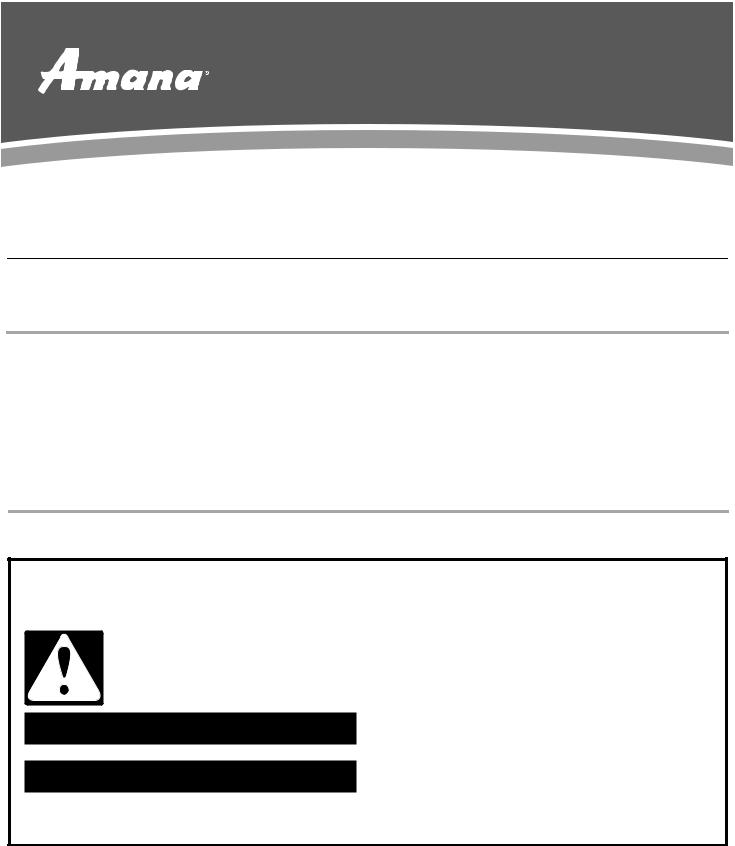
REFRIGERATOR USER INSTRUCTIONS
THANK YOU for purchasing this high-quality product. If you should experience a problem not covered in TROUBLESHOOTING, please visit our website at www.amana.com for additional information. If you still need assistance, call us at 1-800-843-0304. In Canada, visit our website at www.amanacanada.ca or call us at 1-800-807-6777.
You will need your model and serial number, located on the inside wall of the refrigerator compartment.
Para obtener acceso a “Instrucciones para el usuario del refrigerador” en español, o para obtener información adicional acerca de su producto, visite: www.amana.com.
Necesitará su número de modelo y de serie, ubicado en el interior del compartimiento del refrigerador.
TableofContents/Tabledesmatières
REFRIGERATOR SAFETY..................................................................... |
1 |
INSTALLATION INSTRUCTIONS ......................................................... |
2 |
REFRIGERATOR USE ......................................................................... |
11 |
REFRIGERATOR CARE....................................................................... |
13 |
TROUBLESHOOTING.......................................................................... |
14 |
WATER FILTER CERTIFICATIONS .................................................... |
16 |
PRODUCT DATA SHEETS .................................................................. |
17 |
WARRANTY.......................................................................................... |
18 |
SÉCURITÉ DU RÉFRIGÉRATEUR ..................................................... |
19 |
INSTRUCTIONS D’INSTALLATION ................................................... |
20 |
UTILISATION DU RÉFRIGÉRATEUR................................................. |
29 |
ENTRETIEN DU RÉFRIGÉRATEUR ................................................... |
31 |
DÉPANNAGE........................................................................................ |
32 |
FEUILLES DE DONNÉES SUR LE PRODUIT.................................... |
35 |
GARANTIE............................................................................................ |
36 |
REFRIGERATOR SAFETY
Your safety and the safety of others are very important.
We have provided many important safety messages in this manual and on your appliance. Always read and obey all safety messages.
This is the safety alert symbol.
This symbol alerts you to potential hazards that can kill or hurt you and others.
All safety messages will follow the safety alert symbol and either the word “DANGER” or “WARNING.” These words mean:
 DANGER
DANGER
 WARNING
WARNING
You can be killed or seriously injured if you don't immediately follow instructions.
You can be killed or seriously injured if you don't follow instructions.
All safety messages will tell you what the potential hazard is, tell you how to reduce the chance of injury, and tell you what can happen if the instructions are not followed.
W10208785A
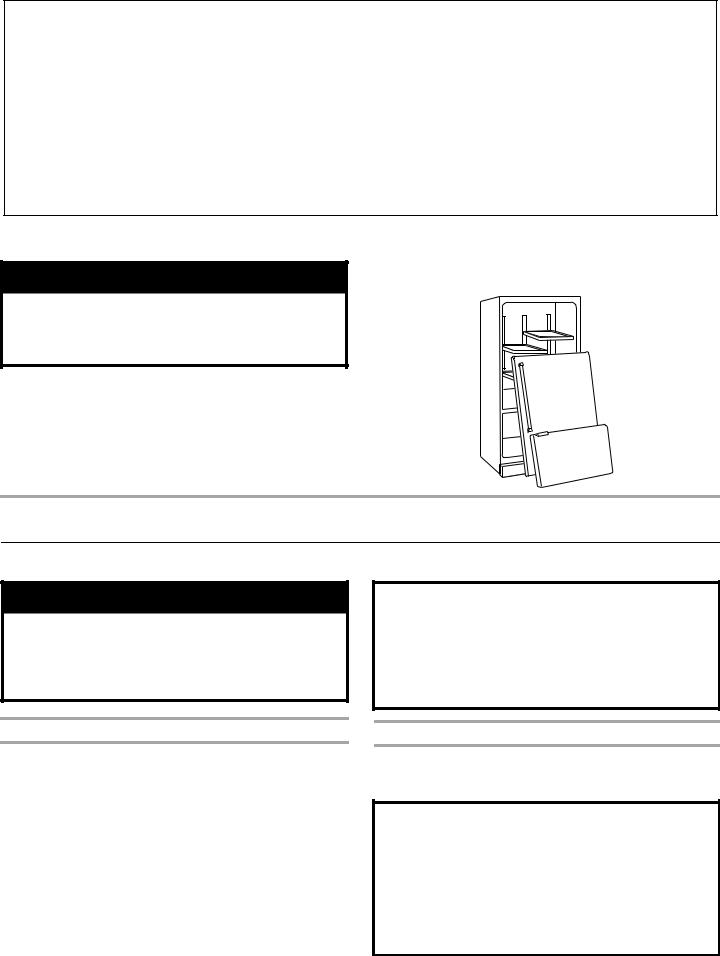
IMPORTANT SAFETY INSTRUCTIONS
WARNING:To reduce the risk of fire, electric shock, or injury to persons when using the refrigerator, follow basic precautions, including the following:
■Plug into a grounded 3 prong outlet.
■Do not remove ground prong.
■Do not use an adapter.
■Do not use an extension cord.
■Disconnect power before servicing.
■Replace all parts and panels before operating.
■Remove doors from your old refrigerator.
■Use nonflammable cleaner.
■Keep flammable materials and vapors, such as gasoline, away from refrigerator.
■Use two or more people to move and install refrigerator.
■Disconnect power before installing ice maker (on ice maker kit ready models only).
SAVE THESE INSTRUCTIONS
Proper Disposal ofYour Old Refrigerator
Before You Throw Away Your Old Refrigerator or Freezer:
■Take off the doors.
 WARNING
WARNING
Suffocation Hazard
Remove doors from your old refrigerator.
Failure to do so can result in death or brain damage.
IMPORTANT: Child entrapment and suffocation are not problems of the past. Junked or abandoned refrigerators are still dangerous
– even if they will sit for “just a few days.” If you are getting rid of your old refrigerator, please follow these instructions to help prevent accidents.
■Leave the shelves in place so that children may not easily climb inside.
INSTALLATION INSTRUCTIONS
UnpacktheRefrigerator
 WARNING
WARNING
Excessive Weight Hazard
Use two or more people to move and install refrigerator.
Failure to do so can result in back or other injury.
When Moving Your Refrigerator:
Your refrigerator is heavy. When moving the refrigerator for cleaning or service, be sure to cover the floor with cardboard or hardboard to avoid floor damage. Always pull the refrigerator straight out when moving it. Do not wiggle or “walk” the refrigerator when trying to move it, as floor damage could occur.
Remove the Packaging
Clean Before Using
■Remove tape and glue residue from surfaces before turning on the refrigerator. Rub a small amount of liquid dish soap over the adhesive with your fingers. Wipe with warm water and dry.
■Do not use sharp instruments, rubbing alcohol, flammable fluids, or abrasive cleaners to remove tape or glue. These products can damage the surface of your refrigerator. For more information, see “Refrigerator Safety.”
■Dispose of/recycle all packaging materials.
After you remove all of the packaging materials, clean the inside of your refrigerator before using it. See the cleaning instructions in “Refrigerator Care.”
Important information to know about glass shelves and covers:
Do not clean glass shelves or covers with warm water when they are cold. Shelves and covers may break if exposed to sudden temperature changes or impact, such as bumping. Tempered glass is designed to shatter into many small, pebble-size pieces. This is normal. Glass shelves and covers are heavy. Use both hands when removing them to avoid dropping.
2

LocationRequirements
 WARNING
WARNING
Explosion Hazard
Keep flammable materials and vapors, such as gasoline, away from refrigerator.
Failure to do so can result in death, explosion, or fire.
To ensure proper ventilation for your refrigerator, allow for a ¹⁄ " (1.25 cm) space at the top and behind the refrigerator. If your refrigerator has an ice maker, allow extra space at the back for the water line connections. When installing your refrigerator next to a fixed wall, leave 2¹⁄ " (6.3 cm) minimum on the hinge side (some models require more) to allow for the door to swing open.
NOTE: It is recommended that you do not install the refrigerator near an oven, radiator, or other heat source. Do not install the refrigerator in a location where the temperature will fall below 55°F (13°C).
¹⁄ " (1.25 cm)
2¹⁄ " (6.3 cm)
ElectricalRequirements
 WARNING
WARNING
Electrical Shock Hazard
Plug into a grounded 3 prong outlet.
Do not remove ground prong.
Do not use an adapter.
Do not use an extension cord.
Failure to follow these instructions can result in death, fire, or electrical shock.
Before you move your refrigerator into its final location, it is important to make sure you have the proper electrical connection.
Recommended Grounding Method
A 115 Volt, 60 Hz., AC only 15or 20-amp fused, grounded electrical supply is required. It is recommended that a separate circuit serving only your refrigerator be provided. Use an outlet that cannot be turned off by a switch. Do not use an extension cord.
NOTE: Before performing any type of installation, cleaning, or removing a light bulb, turn the refrigerator to OFF. Depending on your model, turn the freezer control to the word OFF, or press the Freezer down arrow touch pad until a dash (–) appears in both the Freezer and Refrigerator displays as shown. Disconnect the refrigerator from the electrical source. When you are finished, reconnect the refrigerator to the electrical source and reset the temperature controls to the desired setting. See “Using the Controls.”
Water Supply Requirements
Gather the required tools and parts before starting installation. Read and follow the instructions provided with any tools listed here.
TOOLS NEEDED:
■ |
Flat-blade screwdriver |
■ |
¹⁄ " Nut driver |
■ |
⁄ " and ¹⁄ " Open-end or two |
■ |
¹⁄ " Drill bit |
|
adjustable wrenches |
■ |
Cordless drill |
|
|
IMPORTANT:
■All installations must meet local plumbing code requirements.
■Do not use a piercing-type or ³⁄ " (4.76 mm) saddle valve which reduces water flow and clogs more easily.
■Use copper tubing and check for leaks. Install copper tubing only in areas where the household temperatures will remain above freezing.
■For models with water filters, the disposable water filter should be replaced at least every 6 months.
3
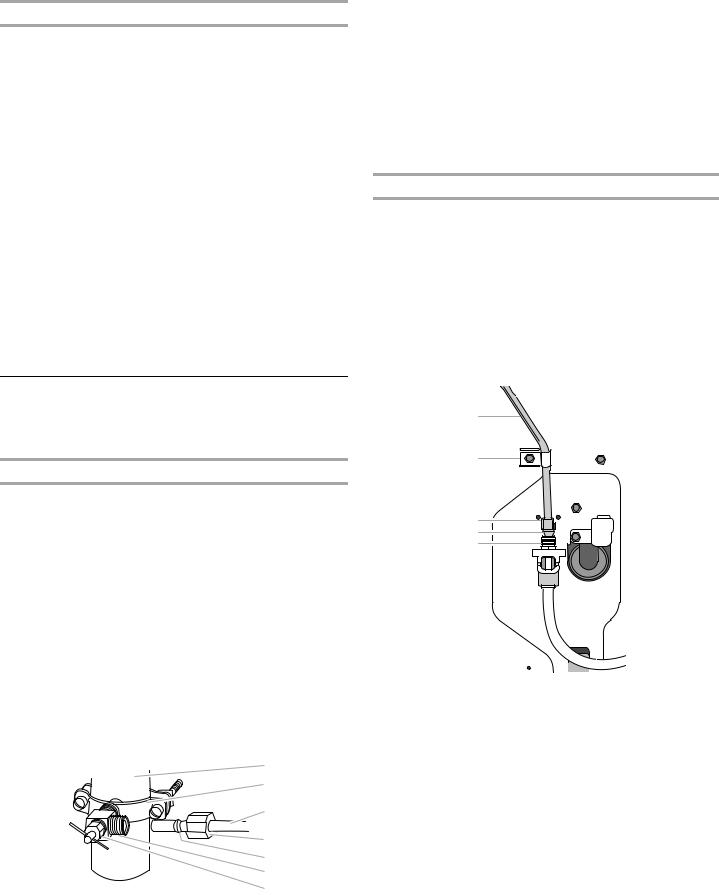
Water Pressure
A cold water supply with water pressure of between 35 and 120 psi (241 and 827 kPa) is required to operate the water
dispenser and ice maker. If you have questions about your water pressure, call a licensed, qualified plumber.
Reverse Osmosis Water Supply
IMPORTANT: The pressure of the water supply coming out of a reverse osmosis system going to the water inlet valve of the refrigerator needs to be between 35 and 120 psi (241 and
827 kPa).
If a reverse osmosis water filtration system is connected to your cold water supply, the water pressure to the reverse osmosis system needs to be a minimum of 40 to 60 psi (276 to 414 kPa).
If the water pressure to the reverse osmosis system is less than 40 to 60 psi (276 to 414 kPa):
■Check to see whether the sediment filter in the reverse osmosis system is blocked. Replace the filter if necessary.
■Allow the storage tank on the reverse osmosis system to refill after heavy usage.
■If your refrigerator has a water filter, it may further reduce the water pressure when used in conjunction with a reverse osmosis system. Remove the water filter. See “Water Filtration System.”
If you have questions about your water pressure, call a licensed, qualified plumber.
ConnecttheWaterSupply
Read all directions before you begin.
IMPORTANT: If you turn the refrigerator on before the water line is connected, turn the ice maker OFF.
Connect to Water Line
1.Unplug refrigerator or disconnect power.
2.Turn OFF main water supply. Turn ON nearest faucet long enough to clear line of water.
3.Find a ¹⁄ " to 1¹⁄ " (12.7 mm to 31.8 mm) vertical cold water pipe near the refrigerator.
IMPORTANT:
■Make sure it is a cold water pipe.
■Horizontal pipe will work, but the following procedure must be followed: Drill on the top side of the pipe, not the bottom. This will help keep water away from the drill. This also keeps normal sediment from collecting in the valve.
4.Determine the length of copper tubing you need. Measure from the connection on the rear of the refrigerator to the water pipe. Add 7 ft (2.1 m) to allow for cleaning. Use ¹⁄ " (6.35 mm) O.D. (outside diameter) copper tubing. Be sure both ends of copper tubing are cut square.
5.Using a cordless drill, drill a ¹⁄ " hole in the cold water pipe you have selected.
|
A |
|
B |
|
C |
|
D |
|
E |
|
F |
|
G |
A. Cold water pipe |
E. Compression sleeve |
B. Pipe clamp |
F. Shutoff valve |
C. Copper tubing |
G. Packing nut |
D. Compression nut |
|
6.Fasten the shutoff valve to the cold water pipe with the pipe clamp. Be sure the outlet end is solidly in the ¹⁄ " drilled hole in the water pipe and that the washer is under the pipe clamp. Tighten the packing nut. Tighten the pipe clamp screws slowly and evenly so the washer makes a watertight seal. Do not overtighten or you may crush the copper tubing.
7.Slip the compression sleeve and compression nut on the copper tubing as shown. Insert the end of the tubing into the outlet end squarely as far as it will go. Screw compression nut onto outlet end with adjustable wrench. Do not overtighten.
8.Place the free end of the tubing in a container or sink, and turn ON the main water supply. Flush the tubing until water is clear. Turn OFF the shutoff valve on the water pipe.
Connect to Refrigerator
Depending on your model, the water line may come down from the top or up from the bottom. Follow the connection instructions for your model.
Style 1
1.Remove plastic cap from water valve inlet port. Attach the copper tube to the valve inlet using a compression nut and sleeve as shown. Tighten the compression nut. Do not overtighten. Confirm copper tubing is secure by pulling on copper tubing.
2.Create a service loop with the copper tubing. Avoid kinks when coiling the copper tubing. Secure copper tubing to refrigerator cabinet with a “P” clamp.
A
B
C
D
E
|
|
|
|
|
|
|
|
|
|
|
|
|
|
|
|
|
|
|
|
|
|
|
|
|
|
|
|
|
|
|
|
|
|
|
|
|
|
|
|
|
|
|
|
|
|
|
|
|
|
|
|
|
|
A. Copper tubing |
D. Compression sleeve |
|||||||
B. “P” clamp |
E. Water valve inlet port |
|||||||
C.Compression nut
3.Turn on water supply to refrigerator and check for leaks. Correct any leaks.
Style 2
1.Create a service loop (minimum diameter of 2 ft [61 cm]) with the copper tubing. Avoid kinks when coiling the copper tubing.
2.Remove the plastic cap from water valve inlet port. Place a compression nut and sleeve on the copper tubing.
4
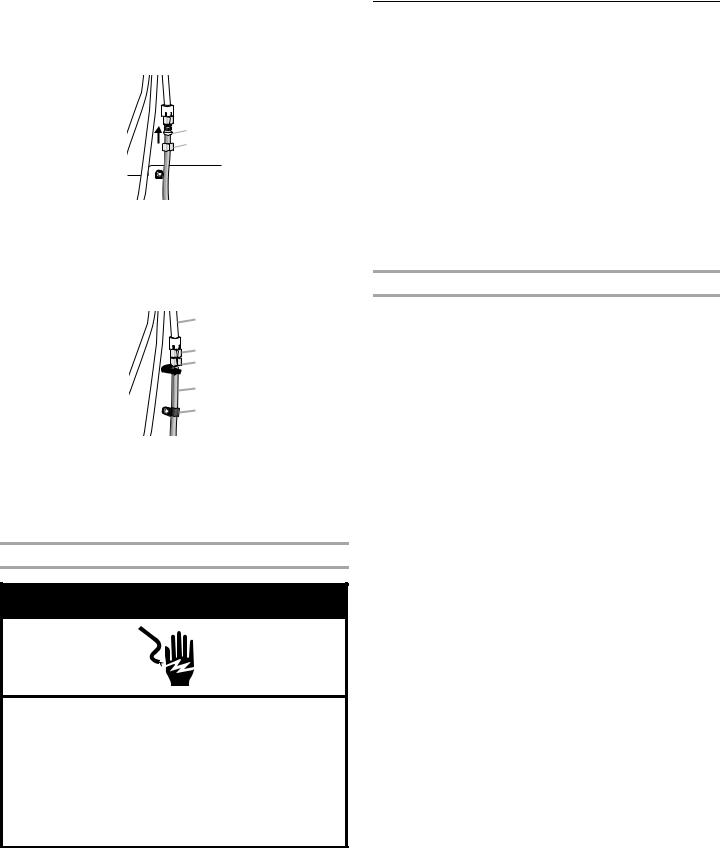
3.Insert the end of the copper tubing into the water valve inlet port. Shape tubing slightly so that the tubing feeds straight into the port to avoid kinks.
4.Slide the compression nut over the sleeve and screw into the water valve inlet port.
 A
A
B
C

 D
D
A. Plastic water tubing |
C. Compression nut |
B. Sleeve |
D. Copper tubing |
5.Using an adjustable wrench, hold the nut on the plastic water line to keep it from moving. Then, with a second wrench turn the compression nut on the copper tubing counterclockwise to completely tighten. Do not overtighten.
|
A |
|
B |
|
C |
|
D |
|
E |
A. Plastic water line |
D. Copper tubing |
B. Water valve inlet port |
E. “P” clamp |
C.Compression nut
6.Check connection by pulling on copper tubing. Attach copper tubing to refrigerator cabinet with a “P” clamp. Turn on water supply to refrigerator and check for leaks. Correct any leaks.
Complete the Installation
 WARNING
WARNING
Electrical Shock Hazard
Plug into a grounded 3 prong outlet.
Do not remove ground prong.
Do not use an adapter.
Do not use an extension cord.
Failure to follow these instructions can result in death, fire, or electrical shock.
1. Plug into a grounded 3 prong outlet.
NOTE: Allow 24 hours to produce the first batch of ice. Discard the first three batches of ice produced. Allow 3 days to completely fill the ice container.
RefrigeratorDoor(s)andDrawer
TOOLS NEEDED: ⁄", ³⁄", ¹⁄" hex-head socket wrench, a #2 Phillips screwdriver, and a flat-blade screwdriver.
IMPORTANT:
■Your refrigerator may have a standard reversible refrigerator door (Style 1) with either a freezer door or freezer drawer, or French doors (Style 2). Follow the instructions specific to the door style of your model.
■All graphics referenced in the following instructions are included later in this section after “Final Steps.” The graphics shown for the standard door (Style 1) are for a right-hand swing refrigerator (hinges factory installed on the right).
■If you only want to remove and replace the doors, see “Remove Door(s) and Hinges” and “Replace Door(s) and Hinges.”
■Before you begin, turn the refrigerator control OFF, and remove food and adjustable door or utility bins from the doors.
Remove and Replace Refrigerator Door Handles
Style 1–Standard Door
Front Mount Handle
■To remove the handle, remove the screw attaching the trim to the upper end of the handle. Using a flat-blade screw driver wrapped in masking tape, pry the trim piece from the lower end of the handle. Then, remove the screws attaching the handle to the door. See Front Mount graphic 2.
■To replace handle, reverse directions.
Side Mount Handle
■To remove the handle, remove the four screws attaching the handle to the side of the door. See Side Mount graphic 2.
■To replace the handle, align the holes in the handle with the holes in the door. Then, insert a screw in the upper hole at each end of the handle. Next, insert a screw in the lower holes. Tighten the screws. See Side Mount graphic 2.
Style 2–French Doors
Metal Handles
■Using a ³⁄" Allen wrench, loosen the two setscrews located on the side of each handle. Pull the handle straight out from the door. Make sure you keep the screws for reattaching the handles. See Metal Handle graphic 1.
■To replace the handles, reverse the directions.
Plastic Handles
■To remove the handle, grasp the lower part of the handle firmly, slide the handle up and pull the handle straight out from the door. See Plastic Handle graphic 1.
■To replace the handle, position the handle so that the large holes in the mounting clips are down and align the holes with the door studs. Rotate the handle so that the mounting clips are flat against the door and slide the handle down to engage. See Plastic Handle graphic 1.
5

Remove Door and Hinges
Style 1–Standard Door
⁄" Hex-Head Top Hinge Screw
Freezer drawer models
1.Unplug refrigerator or disconnect power.
2.Keep the refrigerator door closed until you are ready to lift it free from the cabinet.
NOTE: Provide additional support for the door while the hinges are being moved. Do not depend on the door gasket magnets to hold the door in place while you are working.
3.Remove the parts for the top hinge as shown in Top Hinge graphic. Lift the refrigerator door free from the cabinet.
4.Remove the parts for the bottom hinge as shown in Bottom Hinge graphic.
Freezer door models
1.Unplug refrigerator or disconnect power.
2.Keep the freezer door closed until you are ready to lift it free from the cabinet.
NOTE: Provide additional support for the door while the hinges are being moved. Do not depend on the door gasket magnets to hold the door in place while you are working.
3.Remove the parts for the top hinge as shown in Top Hinge graphic. Lift the refrigerator door free from the cabinet.
4.Remove the center hinge pin and remove the hinge screws as shown in the Center Hinge graphic. Lift the freezer door free from the cabinet.
5.Remove the parts for the bottom hinge as shown in Bottom Hinge graphic.
Style 2–French Doors
 WARNING
WARNING
Electrical Shock Hazard
Disconnect power before removing doors.
Failure to do so can result in death or electrical shock.
1.Unplug refrigerator or disconnect power.
2.Keep the refrigerator doors closed until you are ready to lift them free from the cabinet.
NOTE: Provide additional support for the refrigerator door while the hinges are being removed. Do not depend on the door gasket magnets to hold the door in place while you are working.
3.Starting with the right-hand side door, remove the parts for the top hinge as shown in Top Hinge graphic. Lift the refrigerator door from the bottom hinge pin.
4.Remove the hinge pin cover from the bottom hinge pin and keep it for later use. See Bottom Hinge graphic.
5.Before removing the left-hand side door, disconnect the wiring plug located on top of the top hinge by wedging a flat-blade screwdriver or your fingernail between the two sections. See Wiring Plug graphic.
NOTE: The green, ground wire remains attached to the hinge.
6.Remove the parts for the left-hand side door top hinge as shown in the Top Hinge graphic. Lift the door from the bottom hinge pin.
NOTE: Remove the hinge pin cover from the bottom hinge pin and keep it for later use. See Bottom Hinge graphic.
Reverse Door - Standard Door (optional)
IMPORTANT: If you want to reverse your door so it opens from the opposite side, follow these steps. If you are not reversing the door, see “Replace Door(s) and Hinges.”
Door Stop Screw |
Door Handle Seal Screw Front |
Flat-Head Handle Screw |
Cabinet Hinge Hole Plug |
Cabinet
1.Remove hinge screws from handle side and move them to opposite side. See Graphic 1-1.
2.Remove cabinet hinge hole plugs from cabinet top and move them to opposite side hinge holes as shown in Graphic 1-2.
Refrigerator door
1.Remove the refrigerator handle assembly as shown in Graphic 2. Keep all parts together.
2.Remove door handle seal screw front. Move to opposite side of refrigerator door as shown in Graphic 6.
3.Remove the door stop. Move it to the opposite side of the refrigerator door as shown in Graphic 4.
4.Attach the refrigerator handle to the opposite side of the refrigerator door.
NOTE: For models with Front mount handles, replace the handle trim as shown in Graphic 2.
5.Tighten all screws. Set aside the door until hinges and freezer compartment door or drawer are in place.
Freezer door
1.Remove freezer handle assembly as shown. Keep all parts together. See Graphic 5-1.
2.Remove freezer door handle seal screw. Move to opposite side of freezer door.
3.Remove door stop. Move to opposite side of freezer door as shown. See Graphic 4.
4.Attach handle to opposite side of freezer door.
5.Tighten all screws. Set aside door until bottom hinge is installed on product.
6
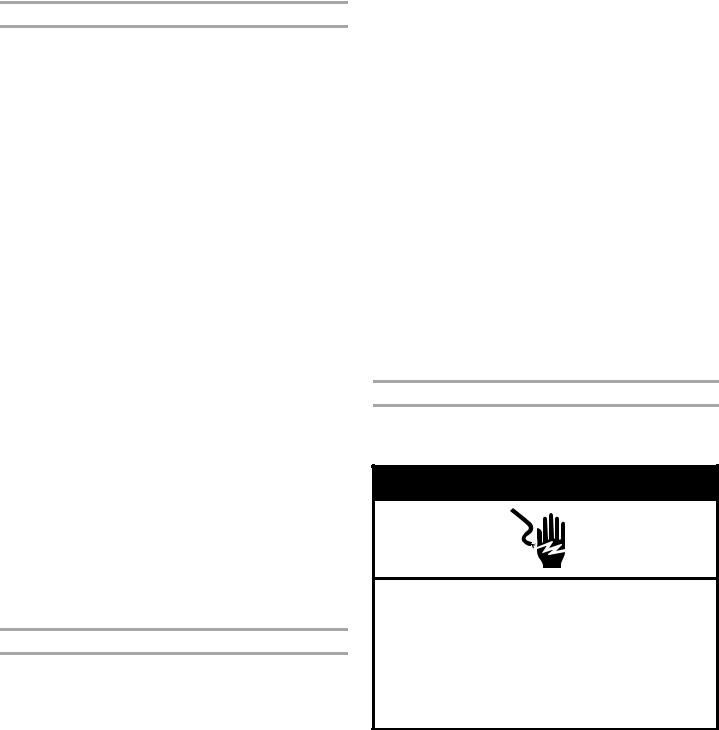
Replace Door and Hinges
Style 1–Standard Door
NOTE: Graphics may be reversed if door swing is reversed.
Freezer drawer models
1.Replace the parts for the bottom hinge as shown. Tighten screws.
NOTE: Provide additional support for the door while the hinges are being moved. Do not depend on the door gasket magnets to hold the door in place while you are working.
2.Assemble the parts for the top hinge as shown in Top Hinge graphic. Do not tighten screws completely.
3.Adjust the door so that the bottom of the refrigerator door is aligned with the top of the freezer drawer. Tighten all screws.
Freezer door models
1.Replace the parts for the bottom hinge as shown. Tighten screws. Replace the freezer door.
NOTE: Provide additional support for the door while the hinges are being moved. Do not depend on the door gasket magnets to hold the door in place while you are working.
2.Assemble the parts for the center hinge as shown in the Center Hinge graphic, and tighten all the screws. Replace the refrigerator door.
3.Assemble the parts for the top hinge as shown in the Top Hinge graphic. Do not tighten the screws completely.
4.Adjust the doors so that the bottom of the refrigerator door is aligned with the top of the freezer door. Tighten all screws.
Style 2–French Doors
1.Assemble the parts for the top hinges as shown in Top Hinge graphic. Do not tighten the screws completely.
2.Replace the parts for the bottom hinges as shown in Bottom Hinge graphic. Tighten screws. Replace the refrigerator doors.
NOTE: Provide additional support for the refrigerator doors while the hinges are being moved. Do not depend on the door gasket magnets to hold the doors in place while you are working.
3.Align each door so that the bottom of the refrigerator door aligns evenly with the top of the freezer drawer. Tighten all screws.
4.Reconnect the wiring plug on top of the left-hand side refrigerator door.
5.Replace the top hinge covers.
Remove and Replace Freezer Drawer
IMPORTANT:
■Two people may be required to remove and replace the freezer drawer.
■All graphics are included later in this section after “Final Steps.”
Remove and Replace Drawer Handle
Metal Handles
■Using a ³⁄" Allen wrench, loosen the two setscrews located on the side of each handle. Pull the handle straight out from the drawer. Make sure you keep the screws for reattaching the handles. See Metal Handle graphic 2.
■To replace the handle, reverse the directions.
Plastic Handles
■To remove the handle, grasp the handle firmly, slide the handle to the left and pull the handle straight out from the drawer. See Plastic Handle graphic 2.
■To replace the handle, position the handle so that the large holes in the mounting clips are to the right and align the holes with the door studs. Rotate the handle so that the mounting clips are flat against the drawer and slide the handle to the right to engage. See Plastic Handle graphic 2.
Remove Drawer Front
1.Open the freezer drawer to full extension.
2.Loosen the four screws attaching the drawer glides to the drawer front. See Drawer Front Removal graphic.
NOTE: Loosen screws three to four turns. Keep the screws in the drawer front.
3.Lift drawer front upward and off the screws. See Drawer Front Removal graphic.
Replace Drawer Front
1.Slide the drawer glides out of the freezer compartment. Insert the screws in the top of the drawer front into the slots in the drawer brackets. See Drawer Front Replacement graphic.
2.Pull the drawer brackets toward you to insert the two screws in the bottom of the drawer front into the brackets. See Drawer Front Replacement graphic.
3.Completely tighten the four screws.
Final Steps
1.Check all holes to make sure that hole plugs and screws are in place. Reinstall top hinge cover as shown in Top Hinge graphic.
 WARNING
WARNING
Electrical Shock Hazard
Plug into a grounded 3 prong outlet.
Do not remove ground prong.
Do not use an adapter.
Do not use an extension cord.
Failure to follow these instructions can result in death, fire, or electrical shock.
2.Plug into a grounded 3 prong outlet.
3.Return all removable door parts to door and food to refrigerator.
7
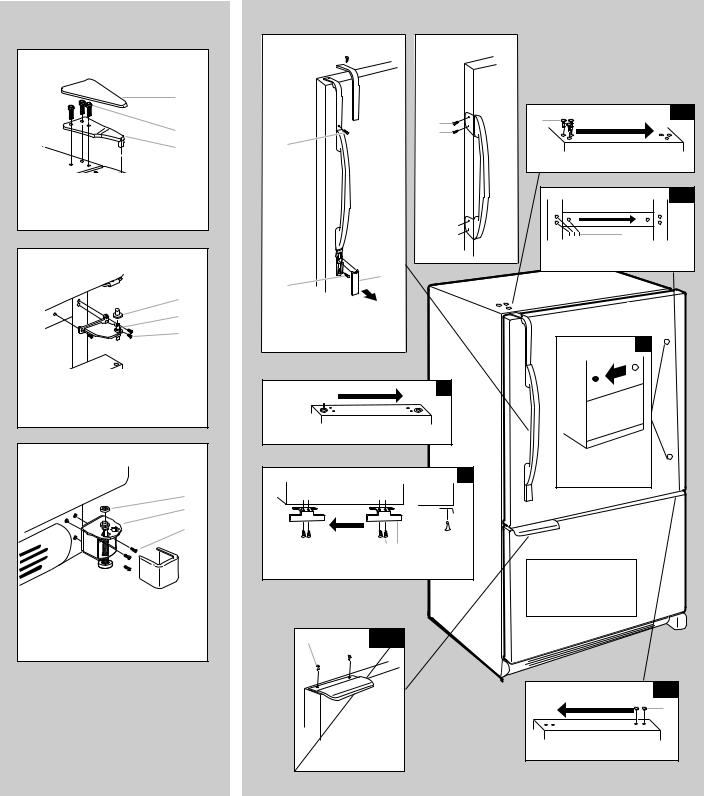
Style 1–Standard Door
Door Removal &
Replacement
Top Hinge
A
B
C
A. Top Hinge Cover
B. ⁄" Hex-Head Hinge Screws
C. Top Hinge
Center Hinge |
A |
B |
C |
A. Hinge Pin Cover |
B. Center Hinge |
C. Hinge Screws |
Bottom Hinge
A
B
C
 D
D
A.Hinge Pin Shim (on some models)
B.Bottom Hinge
C.³⁄" Hex-Head Hinge Screws
D.Bottom Hinge Cover
Door Swing Reversal (optional)
Front Mount |
2 |
Side Mount |
2 |
|
|
A 

C 
1st
3rd
B
2nd 
 4th
4th 

D
B
A.Trim Screw
B.Handle Screws
C.Top Trim
D.Bottom Trim
3
A 

A. Door Hinge Hole Plug
Front View |
Side View |
4 |
A |
B |
|
A. Door Stop Screws |
|
|
B. Door Stop |
|
|
A |
5-1 |
A. Flat-Head Handle |
|
|
Screws |
1-2 |
A |
A. Cabinet Hinge Hole Plugs |
1-1
A1
A. ⁄" Hex-Head Hinge Screws
1 |
6 |
Door Handle |
Seal Screw |
Front |
Some Standard Door models have plastic handles. See French Doors graphic.
5-2 |
A |
A. Door Hinge Hole Plugs |
8
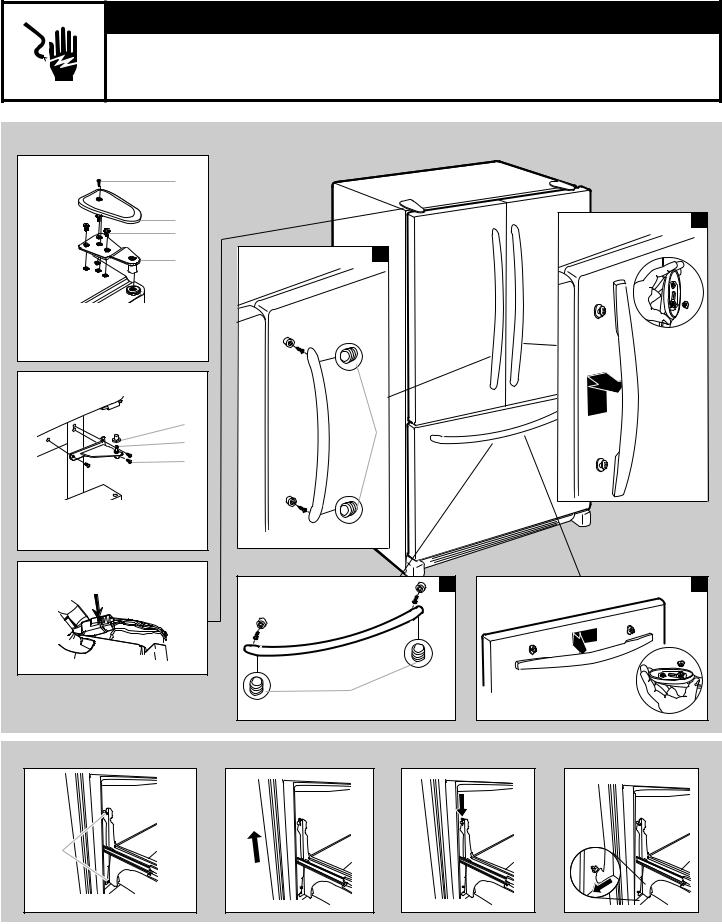
Style 2–French Doors
 WARNING
WARNING
Electrical Shock Hazard
Disconnect power before removing doors.
Failure to do so can result in death or electrical shock.
Top Hinges
A
B
C
D
A.Hinge Cover Screw
B.Top Hinge Cover
C.5/16" Hex Head Hinge Screws
D.Top Hinge
Bottom Hinges |
A |
B |
C |
A. Hinge Pin Cover |
B. Bottom Hinge |
C. Hinge Screws |
Wiring Plug
Door Removal & Replacement
Plastic Handle |
1 |
|
Metal Handle |
1 |
|
A
A. 3/32" Setscrew |
|
|
|
Metal Handle |
2 |
Plastic Handle |
2 |
|
|
||
A |
|
|
|
A. 3/32" Setscrew |
|
|
|
Drawer Front Removal |
Drawer Front Replacement |
A
A. Loosen 4 Door Bracket Screws
9
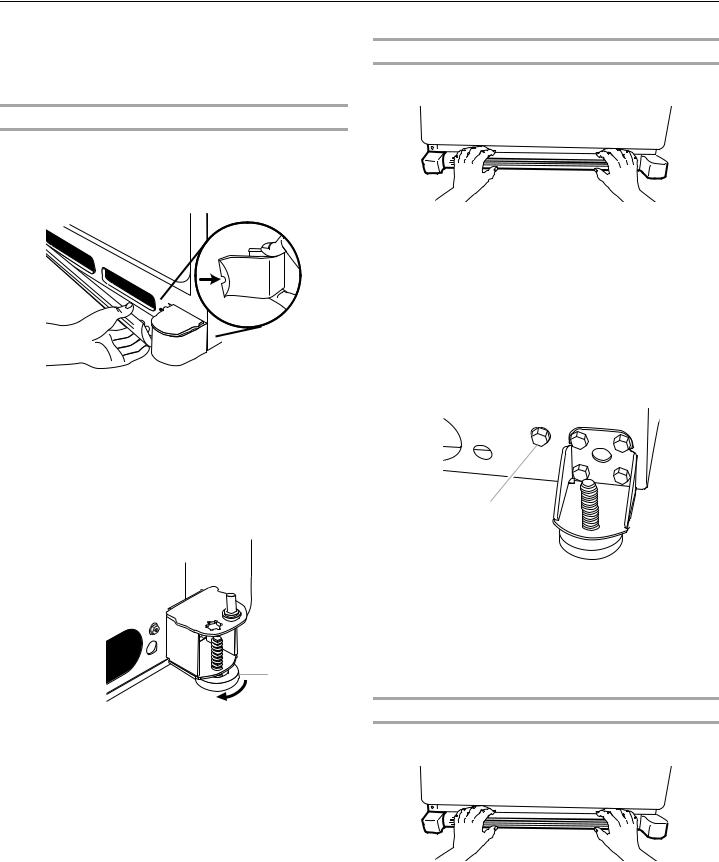
AdjusttheDoor
Depending on your model, your refrigerator may have two front adjustable rollers (Styles 1 and 2), or a leveling screw (Style 3), located at the base of the refrigerator. If your refrigerator seems unsteady or you want the door to close more easily, follow the instructions for your model.
Style1–Freezer Door Models
1.Remove the base grille. Grasp the grille firmly and pull it toward you.
2.Remove the bracket cover. Insert the eraser end of a pencil in the cover notch. Apply slight downward pressure to the notched side of the cover while swinging it off.
3.Using a screwdriver or ³⁄ " hex driver, turn the roller adjustment screw on each side to raise or lower that side of the refrigerator.
NOTE: It may take several turns of the roller adjustment screw to adjust the tilt of the refrigerator.
■To raise, turn the roller adjustment screw to the right.
■To lower, turn the roller adjustment screw to the left.
NOTE: Having someone push against the top of the refrigerator takes some weight off the adjustment screws and rollers. This makes it easier to turn the screws.
A 
B
A.Roller adjustment screw
B.Brake foot
4.Open the door again to make sure that it closes as easily as you like. If not, tilt the refrigerator slightly more to the rear by turning both roller adjustment screws to the right. It may take several more turns, and you should turn both adjustment screws the same amount.
5.Lower the brake foot on each side, by turning it clockwise until it is firmly against floor.
6.Replace the bracket cover. Place the bracket cover into the outer edge, swing the cover toward the cabinet and snap it into place.
7.Replace the base grille.
Style 2–Freezer Drawer Models
1.Remove the base grille. Grasp the grille firmly and pull it toward you.
2.Raise or lower the cabinet. Using a ³⁄ " hex driver, turn the roller adjustment screw(s) on each side to raise or lower that side of the refrigerator.
NOTE: Having someone push against the top of the refrigerator takes some weight off the adjustment screws and rollers. This makes it easier to turn the screws. It may take several turns of the roller adjustment screw to adjust the tilt of the refrigerator.
■To raise, turn the roller adjustment screw to the right.
■To lower, turn the roller adjustment screw to the left.
3.Turn the brake foot clockwise until it is firmly against the floor to keep the refrigerator from rolling forward when the freezer drawer is pulled open.
A
B 
A.Front roller adjustment screw
B.Brake foot
4.Open the door again to make sure that it closes as easily as you like. If not, tilt the refrigerator slightly more to the rear by turning both leveling screws clockwise. It may take several more turns, and you should turn both screws the same amount.
5.Replace the base grille.
Style 3–Leveling Screw
1.Remove the base grille. Grasp the grille firmly and pull it toward you.
10
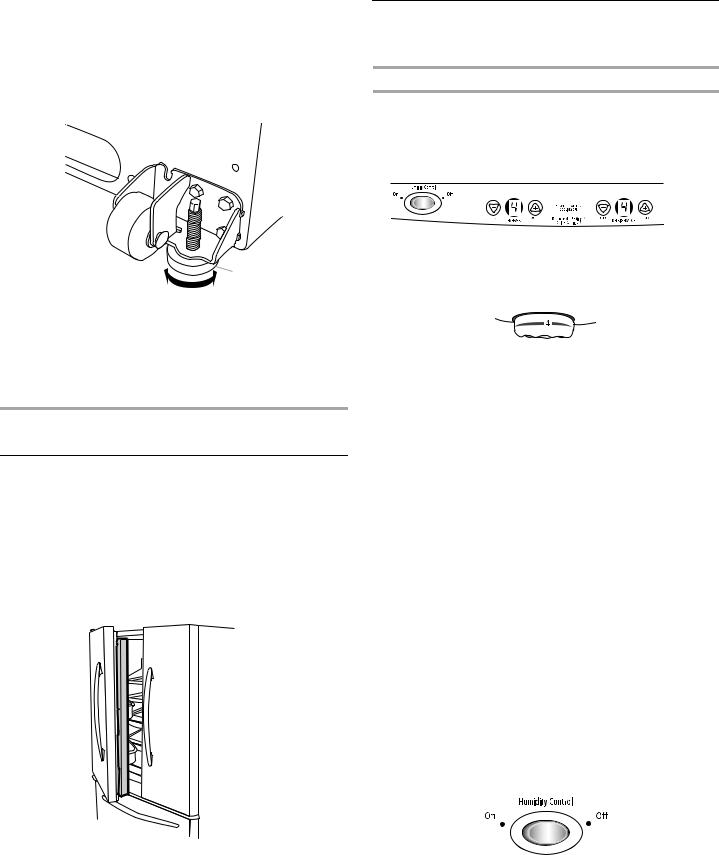
2.Using a ¹⁄" hex driver, turn the leveling screw on each side to raise or lower that side of the refrigerator.
NOTE: Having someone push against the top of the refrigerator takes some weight off the leveling screws. This makes it easier to turn the screws. It may take several turns of the leveling screw to adjust the tilt of the refrigerator.
■To raise, turn the leveling screw clockwise.
■To lower, turn the leveling screw counterclockwise.
A
A.Leveling screw
3.Open the door again to make sure that it closes as easily as you like. If not, tilt the refrigerator slightly more to the rear by turning both leveling screws clockwise. It may take several more turns, and you should turn both screws the same amount.
4.Replace the base grille.
REFRIGERATOR USE
OpeningandClosingDoors
(Frenchdoormodels)
There are two refrigerator compartment doors. The doors can be opened and closed either separately or together.
There is a vertically-hinged seal on the left refrigerator door.
■When the left side door is opened, the hinged seal automatically folds inward so that it is out of the way.
■When both doors are closed, the hinged seal automatically forms a seal between the two doors.
 A
A
A. Hinged seal
UsingtheControls
The temperature controls are located at the top front of the refrigerator or freezer compartments.
Temperature Controls
For your convenience, the temperature controls are preset at the factory. When you first install your refrigerator, make sure the controls are still set to the recommended setting as shown.
Style 1
Recommended Setting “4”
Style 2
Recommended Setting “4”
IMPORTANT:
■The recommended setting should be correct for normal household refrigerator use. The controls are set correctly when milk or juice is as cold as you like and when ice cream is firm.
■Wait 24 hours for your refrigerator to cool completely before adding food. If you add food before the refrigerator has cooled completely, your food may spoil.
NOTE: Adjusting the refrigerator and freezer temperature controls to a colder than recommended setting will not cool the compartments any faster.
■If the temperature is too warm or too cold in the refrigerator or freezer, first check the air vents to be sure they are not blocked before adjusting the controls.
To Turn Off/On:
Style 1 Press the freezer down arrow touch pad until a dash (-) appears in both the refrigerator and freezer displays. Neither compartment will cool.
Style 2 Turn the freezer control to the word OFF. Neither compartment will cool when the freezer is set to OFF.
Humidity Control (on some models)
The humidity control turns on a heater to help reduce moisture on the door hinge seal. Use in humid environments or when you notice moisture on the door hinge seal. The refrigerator uses more energy when Humidity Control is on.
■Press the control to ON when the environment is warm and more humid, or if you notice moisture on the door hinge seal.
■Press the control to OFF to save energy when the environment is less humid.
11
